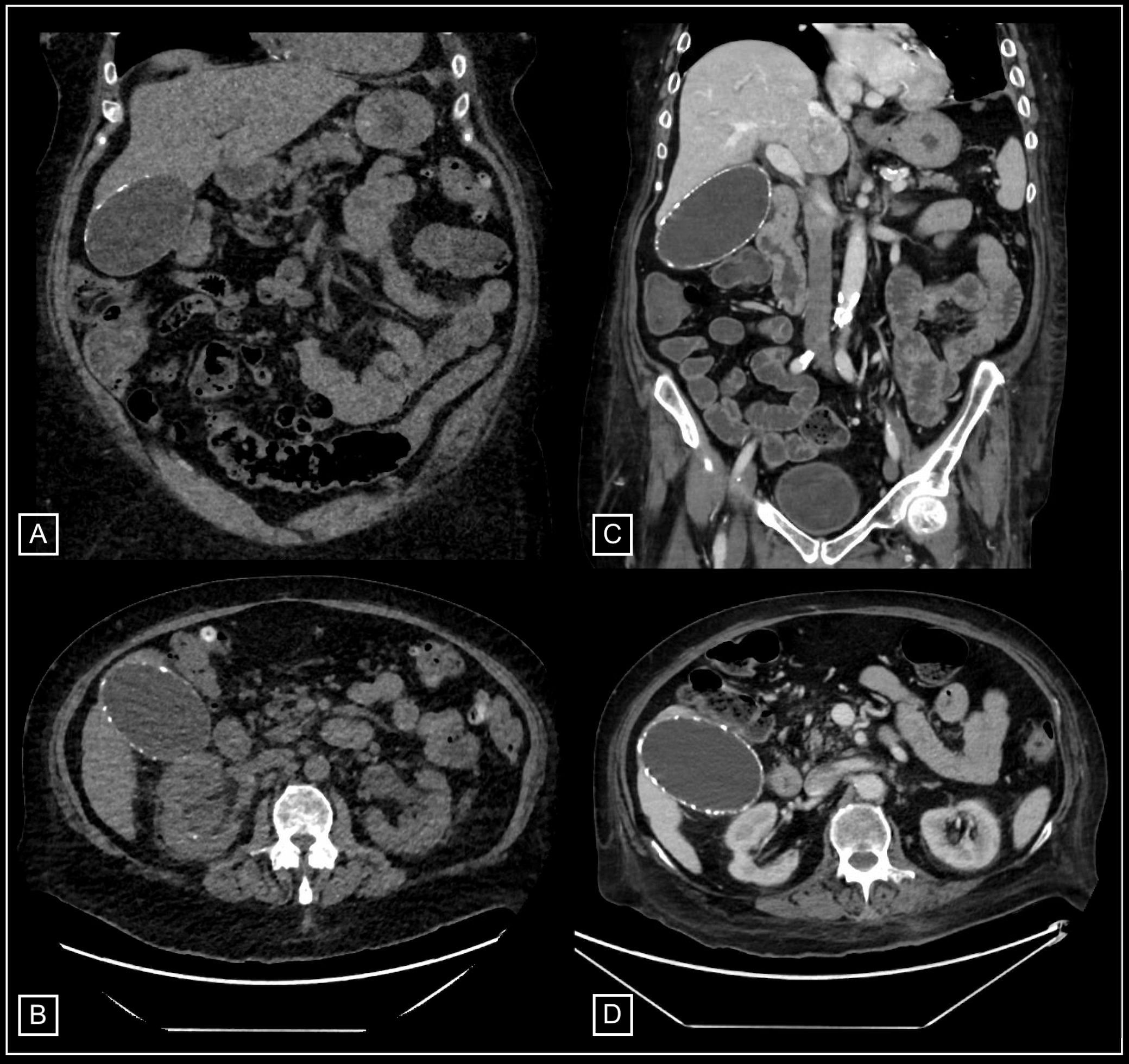Monday Poster Session
Category: Biliary/Pancreas
P2371 - Porcelain Gallbladder Stable After 52 Months of Conservative Management
Monday, October 27, 2025
10:30 AM - 4:00 PM PDT
Location: Exhibit Hall

Rishab Belavadi, MBBS
Mayo Clinic
Phoenix, AZ
Presenting Author(s)
Kaiser O'Sahil Sadiq, MBBS1, Rishab Belavadi, MBBS2
1George Washington University, Washington, DC; 2Mayo Clinic, Phoenix, AZ
Introduction: Porcelain gallbladder, characterized by calcification of the gallbladder wall, is a rare condition often associated with an increased risk of gallbladder carcinoma. It is most often asymptomatic and found incidentally. This case describes the incidental discovery of diffuse mural calcification of the gallbladder in a 60-year-old male with multiple comorbidities.
Case Description/
Methods: A 60-year-old male with a medical history of nonischemic cardiomyopathy, chronic diarrhea, psoriasis, type II diabetes, and blindness was undergoing a CT intravenous pyelogram for nephrolithiasis. Incidentally, the scan revealed diffuse mural calcification of the gallbladder, consistent with a porcelain gallbladder (Fig 1). The patient was asymptomatic, with no signs of biliary colic, cholecystitis, biliary dyskinesia, choledocholithiasis, or pancreatitis.
At the time of the discovery, the patient had no abdominal symptoms attributable to the biliary system, which remained consistent during follow-up. A repeat CT scan 52 months later demonstrated a porcelain gallbladder of similar size (Fig 1), with no evidence of new symptoms or complications.
Given the patient's advanced age and multiple comorbidities, the decision was made to manage the condition conservatively. He was advised against surgical resection due to the potential risks outweighing the benefits in this context.
Discussion: Porcelain gallbladder may be asymptomatic in 82% of patients. Despite the theoretical risk of gallbladder carcinoma, recent studies suggest that this risk may be lower than initially thought. Intramural calcification has lower malignant potential, and prophylactic cholecystectomy may be avoided, especially in asymptomatic patients with significant perioperative risks.
This case highlights the incidental finding of porcelain gallbladder in a patient with multiple comorbidities and underscores the importance of individualized decision-making regarding management. In cases where patients are asymptomatic and at high surgical risk, conservative management may be a reasonable approach.

Figure: Fig 1. (A) Coronal and (B) axial sections of CT intravenous pyelogram showing distended gallbladder with intramural calcification. (C) Coronal and (D) axial sections of CT abdomen and pelvis without contrast 52 months later.
Disclosures:
Kaiser O'Sahil Sadiq indicated no relevant financial relationships.
Rishab Belavadi indicated no relevant financial relationships.
Kaiser O'Sahil Sadiq, MBBS1, Rishab Belavadi, MBBS2. P2371 - Porcelain Gallbladder Stable After 52 Months of Conservative Management, ACG 2025 Annual Scientific Meeting Abstracts. Phoenix, AZ: American College of Gastroenterology.
1George Washington University, Washington, DC; 2Mayo Clinic, Phoenix, AZ
Introduction: Porcelain gallbladder, characterized by calcification of the gallbladder wall, is a rare condition often associated with an increased risk of gallbladder carcinoma. It is most often asymptomatic and found incidentally. This case describes the incidental discovery of diffuse mural calcification of the gallbladder in a 60-year-old male with multiple comorbidities.
Case Description/
Methods: A 60-year-old male with a medical history of nonischemic cardiomyopathy, chronic diarrhea, psoriasis, type II diabetes, and blindness was undergoing a CT intravenous pyelogram for nephrolithiasis. Incidentally, the scan revealed diffuse mural calcification of the gallbladder, consistent with a porcelain gallbladder (Fig 1). The patient was asymptomatic, with no signs of biliary colic, cholecystitis, biliary dyskinesia, choledocholithiasis, or pancreatitis.
At the time of the discovery, the patient had no abdominal symptoms attributable to the biliary system, which remained consistent during follow-up. A repeat CT scan 52 months later demonstrated a porcelain gallbladder of similar size (Fig 1), with no evidence of new symptoms or complications.
Given the patient's advanced age and multiple comorbidities, the decision was made to manage the condition conservatively. He was advised against surgical resection due to the potential risks outweighing the benefits in this context.
Discussion: Porcelain gallbladder may be asymptomatic in 82% of patients. Despite the theoretical risk of gallbladder carcinoma, recent studies suggest that this risk may be lower than initially thought. Intramural calcification has lower malignant potential, and prophylactic cholecystectomy may be avoided, especially in asymptomatic patients with significant perioperative risks.
This case highlights the incidental finding of porcelain gallbladder in a patient with multiple comorbidities and underscores the importance of individualized decision-making regarding management. In cases where patients are asymptomatic and at high surgical risk, conservative management may be a reasonable approach.

Figure: Fig 1. (A) Coronal and (B) axial sections of CT intravenous pyelogram showing distended gallbladder with intramural calcification. (C) Coronal and (D) axial sections of CT abdomen and pelvis without contrast 52 months later.
Disclosures:
Kaiser O'Sahil Sadiq indicated no relevant financial relationships.
Rishab Belavadi indicated no relevant financial relationships.
Kaiser O'Sahil Sadiq, MBBS1, Rishab Belavadi, MBBS2. P2371 - Porcelain Gallbladder Stable After 52 Months of Conservative Management, ACG 2025 Annual Scientific Meeting Abstracts. Phoenix, AZ: American College of Gastroenterology.
